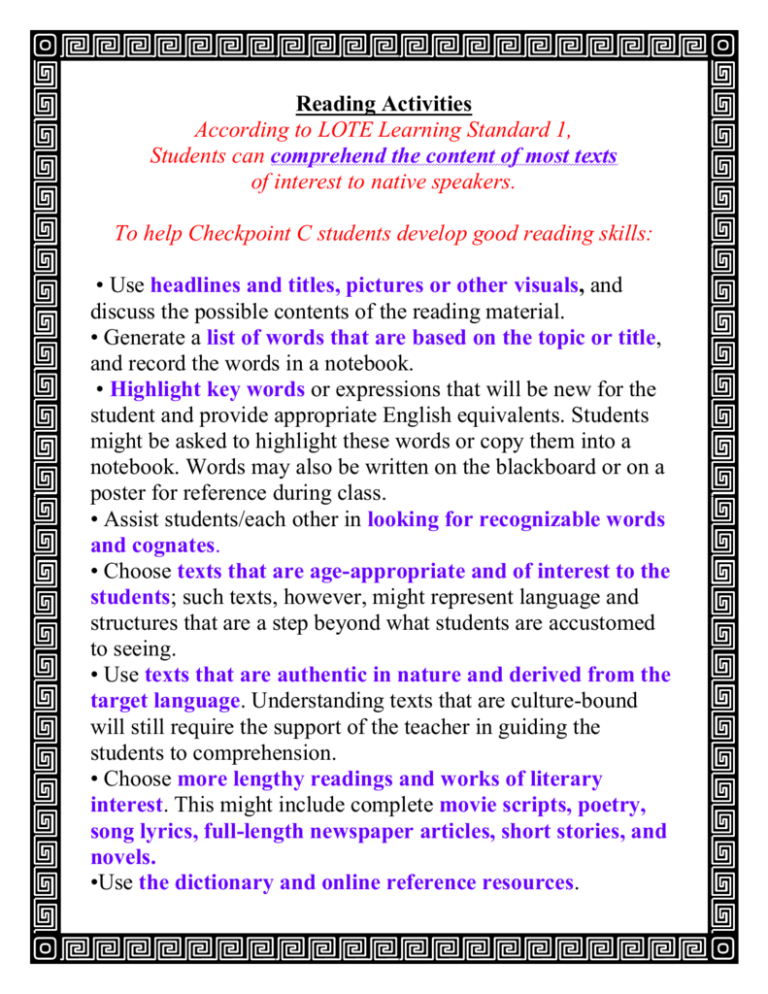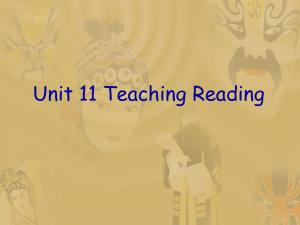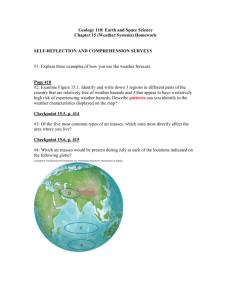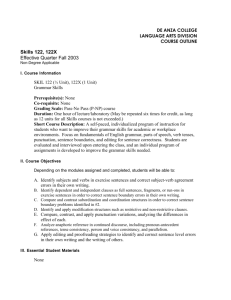Reading and Writing Strategies Handout to Students
advertisement

Reading Activities According to LOTE Learning Standard 1, Students can comprehend the content of most texts of interest to native speakers. To help Checkpoint C students develop good reading skills: • Use headlines and titles, pictures or other visuals, and discuss the possible contents of the reading material. • Generate a list of words that are based on the topic or title, and record the words in a notebook. • Highlight key words or expressions that will be new for the student and provide appropriate English equivalents. Students might be asked to highlight these words or copy them into a notebook. Words may also be written on the blackboard or on a poster for reference during class. • Assist students/each other in looking for recognizable words and cognates. • Choose texts that are age-appropriate and of interest to the students; such texts, however, might represent language and structures that are a step beyond what students are accustomed to seeing. • Use texts that are authentic in nature and derived from the target language. Understanding texts that are culture-bound will still require the support of the teacher in guiding the students to comprehension. • Choose more lengthy readings and works of literary interest. This might include complete movie scripts, poetry, song lyrics, full-length newspaper articles, short stories, and novels. •Use the dictionary and online reference resources. • Continue to teach/learn vocabulary that connects to English vocabulary through cognates and root words. • Use folktales of the target language as an entry point to understanding the culture better. •Take classroom time to read aloud. • Check for understanding in the target language and in English. • Ask for written and oral summaries of texts to check for comprehension. • Allow student choice in reading material. • Give the students an opportunity to work together to determine the meaning of new text. Have them read aloud, alternating lines or paragraphs. (Note that reading aloud represents the ability to articulate sound-symbol relationships, but should not imply comprehension of the text.) • Ask students to underline, circle, or highlight the key ideas in the text. • Ask students to summarize the text in their own words, in English. • Ask students to share, in their own words, their understanding of a passage. • Ask students to read the text again, perhaps with side glosses, for new vocabulary and expressions. This rereading will assist with reading comprehension and will demonstrate to students that reading may require several tries in order to fully grasp meaning and details. Writing Activities Writing allows students to 1. Reinforce reading and listening skills 2. Develop grammar, spelling, and vocabulary 3. Express factual information and personal reactions to reading material and classroom conversations. Checkpoint C writing activities differ from other checkpoint writing. They are often used as the basis for classroom presentations, thus further integrating and linking all of the language skills. Checkpoint C students should be given opportunities to: • Brainstorm for main ideas, needed vocabulary, and structures • Prepare a rough draft, share the draft with peers, revise and polish the rough draft, then prepare the final product • Use/Draw on a broad range of learned vocabulary, idioms, and structures, including the full range of time frames (verb tenses) • Use/Draw on language acquired through independent reading • Write multiparagraphed essays, journals, personal and business letters, and creative texts in which their thoughts are presented in an organized fashion; errors in form may occur, particularly when the students are writing about complex issues requiring the expression of opinions, or when the topic is outside their realm of experience • Use culturally-appropriate learned vocabulary and structures associated with a broad range of topics, and structures such as simple and complex sentences to communicate • Use dictionaries and practice old and new structural elements of the language • Use Spanish/(LOTE) for creative writing, such as: rewriting the ending to a story, song, or poem; changing the main character of a recently read story; composing an additional chapter to a recently completed text writing; illustrating an original story/poem; creating a story for use in a Checkpoint A or Checkpoint B classroom; writing a letter to the principal trying to change his/her opinions regarding a school policy; and writing a group play in which all students contribute to the writing.











